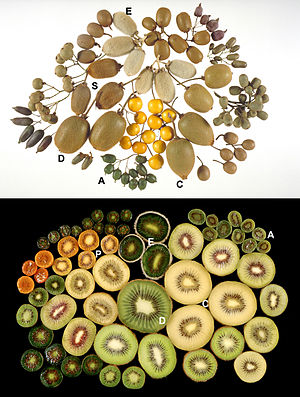Difference between revisions of "Actinidia"
Jump to navigation
Jump to search
m (1 revision: Actinidia) |
(Start article) |
||
| Line 8: | Line 8: | ||
| type_species_authority = Lindl. | | type_species_authority = Lindl. | ||
}} | }} | ||
| − | |||
| − | The | + | The genus '''''Actinidia''''' contains the common [[kiwifruit]] (''Actinidia deliciosa''), the hardy kiwi or kiwi berry (''[[Actinidia arguta]]''), and many other species whose berries have varying degrees of edibility. |
| − | |||
| − | |||
| − | |||
== Species == | == Species == | ||
| + | [[File:Actinidia fruits.jpg|thumb|''Actinidia'' spp. fruits<br/>A = ''A. arguta'', C = ''A. chinensis'', D = ''A. deliciosa'', E = ''A. eriantha'', I = ''A. indochinensis'', P = ''A. polygama'', S = ''A. setosa'']] | ||
The 40–60 [[species]] of ''Actinidia'' include: | The 40–60 [[species]] of ''Actinidia'' include: | ||
{{div col|colwidth=24em}} | {{div col|colwidth=24em}} | ||
| Line 128: | Line 125: | ||
*''[[Actinidia zhejiangensis]]'' | *''[[Actinidia zhejiangensis]]'' | ||
{{div col end}} | {{div col end}} | ||
| − | |||
| − | |||
| − | |||
| − | |||
| − | |||
| − | |||
| − | |||
| − | |||
==References== | ==References== | ||
{{Reflist}} | {{Reflist}} | ||
| − | + | {{Ack-Wikipedia}} | |
| − | {{ | ||
| − | |||
| − | |||
| − | |||
[[Category:Actinidia| ]] | [[Category:Actinidia| ]] | ||
[[Category:Ericales genera]] | [[Category:Ericales genera]] | ||
| − | |||
Revision as of 19:42, 4 June 2017
| Actinidia | |
|---|---|

| |
| Actinidia kolomikta ('Arctic Beauty') | |
| Scientific classification | |
| Kingdom: | Plantae |
| Clade: | Angiosperms |
| Clade: | Eudicots |
| Clade: | Asterids |
| Order: | Ericales |
| Family: | Actinidiaceae |
| Genus: | Actinidia Lindl. |
| Type species | |
| Actinidia callosa [1] Lindl.
| |
The genus Actinidia contains the common kiwifruit (Actinidia deliciosa), the hardy kiwi or kiwi berry (Actinidia arguta), and many other species whose berries have varying degrees of edibility.
Species
The 40–60 species of Actinidia include:
- Actinidia arguta – kokuwa, tara vine or hardy kiwi
- A. arguta var. cordifolia
- A. arguta var. giraldii
- A. arguta var. nervosa
- A. arguta var. purpurea
- Actinidia arisanensis
- Actinidia callosa
- A. callosa var. acuminata
- A. callosa var. discolor
- A. callosa var. ephippioides
- A. callosa var. formosana
- A. callosa var. henryi
- A. callosa var. strigillosa
- Actinidia carnosifolia
- A. carnosifolia var. glaucescens
- Actinidia chengkouensis
- Actinidia chinensis
- A. chinensis var. hispida
- A. chinensis var. jinggangshanensis
- A. chinensis var. setosa
- Actinidia chrysantha
- Actinidia cinerascens
- A. cinerascens var. longipetiolata
- A. cinerascens var. tenuifolia
- Actinidia cordifolia
- Actinidia coriacea
- Actinidia cylindrica
- A. cylindrica f. obtusifolia[citation needed]
- Actinidia deliciosa – kiwifruit, mi hou tao or Chinese gooseberry
- Actinidia eriantha
- Actinidia farinosa
- Actinidia fasciculoides
- A. fasciculoides var. cuneata
- A. fasciculoides var. orbiculata
- †Actinidia faveolata
- Actinidia fortunatii
- †Actinidia foveolata
- Actinidia fulvicoma
- A. fulvicoma var. lanata
- A. fulvicoma var. lanata f. arachnoidea[citation needed]
- A. fulvicoma var. lanata f. hirsuta[citation needed]
- A. fulvicoma var. pachyphylla
- A. fulvicoma var. lanata
- †Actinidia germanica
- Actinidia glauco-callosa-callosa
- Actinidia glaucophylla
- A. glaucophylla var. asymmetrica
- A. glaucophylla var. robusta
- Actinidia globosa
- Actinidia gracilis
- Actinidia grandiflora
- Actinidia hemsleyana
- A. hemsleyana var. kengiana
- Actinidia henryi
- A. henryi var. glabricaulis
- A. henryi var. polyodonta
- Actinidia holotricha
- Actinidia hubeiensis
- Actinidia indochinensis
- Actinidia kolomikta
- Actinidia laevissima
- Actinidia lanceolata
- Actinidia latifolia
- A. latifolia var. mollis
- Actinidia leptophylla
- Actinidia liangguangensis
- Actinidia lijiangensis
- Actinidia linguiensis
- Actinidia longicarpa
- Actinidia macrosperma
- A. macrosperma var. mumoides
- Actinidia maloides
- A. maloides f. cordata[citation needed]
- Actinidia melanandra
- A. melanandra var. cretacea
- A. melanandra var. glabrescens
- A. melanandra var. kwangsiensis
- A. melanandra var. subconcolor
- Actinidia melliana
- Actinidia obovata
- †Actinidia oregonensis[2]
- Actinidia persicina
- Actinidia pilosula
- Actinidia polygama – silver vine
- Actinidia purpurea
- Actinidia rongshuiensis
- Actinidia rubricaulis
- A. rubricaulis var. coriacea
- Actinidia rubus
- Actinidia rudis
- Actinidia rufa
- Actinidia rufotricha
- A. rufotricha var. glomerata
- Actinidia sabiaefolia
- Actinidia sorbifolia
- Actinidia stellato-pilosa-pilosa
- Actinidia styracifolia
- Actinidia suberifolia
- Actinidia tetramera
- A. tetramera var. badongensis
- Actinidia trichogyna
- Actinidia ulmifolia
- Actinidia umbelloides
- A. umbelloides var. flabellifolia
- Actinidia valvata
- A. valvata var. boehmeriaefolia
- Actinidia venosa
- A. venosa f. pubescens
- Actinidia vitifolia
- Actinidia zhejiangensis
References
- ↑ Xin-Wei Li & Jian-Qiang Li (2007). "Lectotypification of Actinidia". Nordic Journal of Botany. 25 (5–6): 294–295. doi:10.1111/j.0107-055X.2008.00166.x.
- ↑ Manchester, S.R. (1994). "Fruits and Seeds of the Middle Eocene Nut Beds Flora, Clarno Formation, Oregon". Palaeontographica Americana. 58: 30–31.
Acknowledgements
This article uses material from the Wikipedia article Actinidia, which is released under the Creative Commons Attribution-Share-Alike License 3.0.
